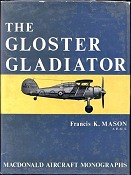 Francis K. Mason, “The Gloster Gladiator”, Macdonald Aircraft Monographs
(unnumbered), ©1964 Macdonald & Co. London, England. No ISBN.
Francis K. Mason, “The Gloster Gladiator”, Macdonald Aircraft Monographs
(unnumbered), ©1964 Macdonald & Co. London, England. No ISBN.The Gloster aircraft factories achieved perhaps the biggest achievement during world war two: they built the RAF’s first jet fighter, the Gloster Meteor, while they started with the RAF’s last biplane fighter, the Gloster Gladiator. Despite it’s almost immediate obsolescence and the relatively small numbers built, that Gloster Gladiator was used on al fronts during World war two by a surprising number of combatants –on both sides!-, making this plane great for conversions to a unique version, like Greek, Finnish, Egyptian, or Chinese. It was also flown by neutral countries like Portugal and Ireland as well as those overrun by the Soviets; Latvia and Lithuania. But you might want to build a very colorful pre-war British version instead. Which reference are you going to use?
In this overview I will present the Gladiator references from my own library, mentioning their strong and weak points from my point of view (keeping the modeller in mind). In chronological sequences of their first publishing date they are:
 Francis K. Mason, “The Gloster Gladiator”, Macdonald Aircraft Monographs
(unnumbered), ©1964 Macdonald & Co. London, England. No ISBN.
Francis K. Mason, “The Gloster Gladiator”, Macdonald Aircraft Monographs
(unnumbered), ©1964 Macdonald & Co. London, England. No ISBN.
Pros: seldom in aviation history has there been a first monograph covering an aircraft this good. Excellent history, very good photography. A real classic of 1960ies aviation history.
The standard reference for more than 30 years.
Cons: though great on history, not a great help for a modeller who wants to build something else than the model from the box. Few detail pics, color art leaves to be desired by nowadays standards and is confined to British versions.
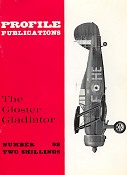 Francis K. Mason, “The Gloster Gladiator”, Aircraft in Profile no. 98,
©1966 Profile Publications ltd., Coburg House, Sheet Street, Windsor,
Berkshire, England. No ISBN
Francis K. Mason, “The Gloster Gladiator”, Aircraft in Profile no. 98,
©1966 Profile Publications ltd., Coburg House, Sheet Street, Windsor,
Berkshire, England. No ISBN
Pros: as usual with the profiles series you get very much compared to the amount of pages, in this case a whopping 16, quite a lot for an old profile. The color art is better than it’s big brother by the same writer and much more diverse.
Cons: as usual with the profiles series: it is long out of print, so hard to get. Costs of second hand profiles are sometimes as high as later, bigger and better books. Still worth hunting for though.
 Bartłomiej Belcarz
and Robert Pęczkowski, “Gloster Gladiator”, Monografie Lotnicze 24, ©1996
AJ-Press, Gdansk, Poland, ISBN: 83-86208-34-1.
Bartłomiej Belcarz
and Robert Pęczkowski, “Gloster Gladiator”, Monografie Lotnicze 24, ©1996
AJ-Press, Gdansk, Poland, ISBN: 83-86208-34-1.
Pros: very good color art and detail, excellent on scale plan and drawings.
Cons: apart from the point that not everybody will be able to read the Polish text, the photography is badly reproduced in the printing process, it is much too dark. Compare the pictures to the Mason book and you will see what I mean.
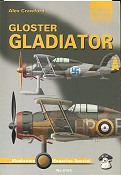 Alex Crawford,
“Gloster Gladiator”, Mushroom yellow series 4, ©2002 Stratus, 27-600
Sandomierz, Poland/Mushroom Model Publications, Redbourn AL3 7PE, England.
Alex Crawford,
“Gloster Gladiator”, Mushroom yellow series 4, ©2002 Stratus, 27-600
Sandomierz, Poland/Mushroom Model Publications, Redbourn AL3 7PE, England.
ISBN 83-916327-0-9.
Pros: essentially almost all the content of the former web pages about the Gloster Gladiator by the author, it offers almost everything of the Mason book does and more. Excellent on detail, the color section is devoted to it. Has as only Gladiator reference a bibliography, and a good one at that.
Cons: does not include the section of the author’s former web pages about Gladiator modelling, which offered very valuable detail information aimed at modellers.
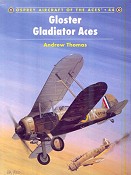 Andrew Thomas,
“Gloster Gladiator Aces”, series Osprey Aircraft of the Aces no.44, ©2002,
Osprey Publishing, Oxford OX2 9LP, England. ISBN 1-84176-289-X.
Andrew Thomas,
“Gloster Gladiator Aces”, series Osprey Aircraft of the Aces no.44, ©2002,
Osprey Publishing, Oxford OX2 9LP, England. ISBN 1-84176-289-X.
Pros: fascinating history, lots of side views. Photography and artwork go very well together.
Cons: no wing camouflage detail to go with the side views, some side view colors are badly reproduced, especially when compared to other references.
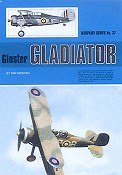 Tom Spencer, “Gloster
Gladiator”, Warpaint series no. 37, ©2002 Warpaint Books Ltd.
Luton, Bedfordshire LU4 8NU, England.
ISBN X-9999-00373.
Tom Spencer, “Gloster
Gladiator”, Warpaint series no. 37, ©2002 Warpaint Books Ltd.
Luton, Bedfordshire LU4 8NU, England.
ISBN X-9999-00373.
Pros: great on side views, good photography and scale plan. Has as only Gladiator reference a small kits and accessories section mentioning all various kits that have been produced during the years in 1:72, 1:48, 1:32 and 1:24, together with all accessories and decals.
Cons: not very much close-up detail (but what there is is almost all in color).
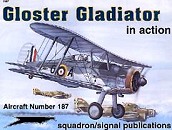 W.A. Harrison,
“Gloster Gladiator in Action”, series Aircraft in Action no. 187, ©2003
Squadron/Signal Publications, inc., Carrollton, Texas 75011-5010, USA
W.A. Harrison,
“Gloster Gladiator in Action”, series Aircraft in Action no. 187, ©2003
Squadron/Signal Publications, inc., Carrollton, Texas 75011-5010, USA
ISBN 0-89747-450-3.
Pros: very good color art and photography. Better than a lot of other ‘In Actions’ on historic information.
Cons: the more way view/scale plane has no scale mentioned, there are no cross sections.
No wing camouflage detail.

Those who want more information about the camouflage and markings of British Gladiators could search for either the separately published part 5 (Gloster Gauntlet, Gladiator, Hawker Fury, Demon) or the bound volume of
James Goulding and Robert Jones, “Camouflage & Markings, RAF Fighter Command Northern Europe, 1936 to 1945”, ©1970-1971 Ducimus Books Ltd., London SW13, England
No ISBN
Detailed company history with a chapter on the Gladiator is given in:
Derek N. James, “Gloster Aircraft Since 1917”, ©1987 Putnam Aeronautical Books,
ISBN: 0 85177 807 0
The era of RAF biplane fighters is nicely described and illustrated in:
Alex Lumsden and Owen Thetford, “On Silver Wings: RAF Biplane Fighters Between the Wars”, Osprey Classic Aircraft ©1993 Osprey Publishing, Oxford OX2 9LP, England.
ISBN 1-85532-374-5. Another out-of-print Osprey gem.
Use of the Gladiator is described amongst others in various books published about the history of the famous 112 ‘shark’ squadron (a.o. Kagero, Crécy)
Some very useful sites to hunt for more information about the Gloster Gladiator:
http://www.ipmsstockholm.org/magazine/1999/10/stuff_eng_profile_gladiator1.htm
http://surfcity.kund.dalnet.se/gladiator.htm
http://www.aeroflight.co.uk/types/uk/gloster/gladiator/gladiator.htm